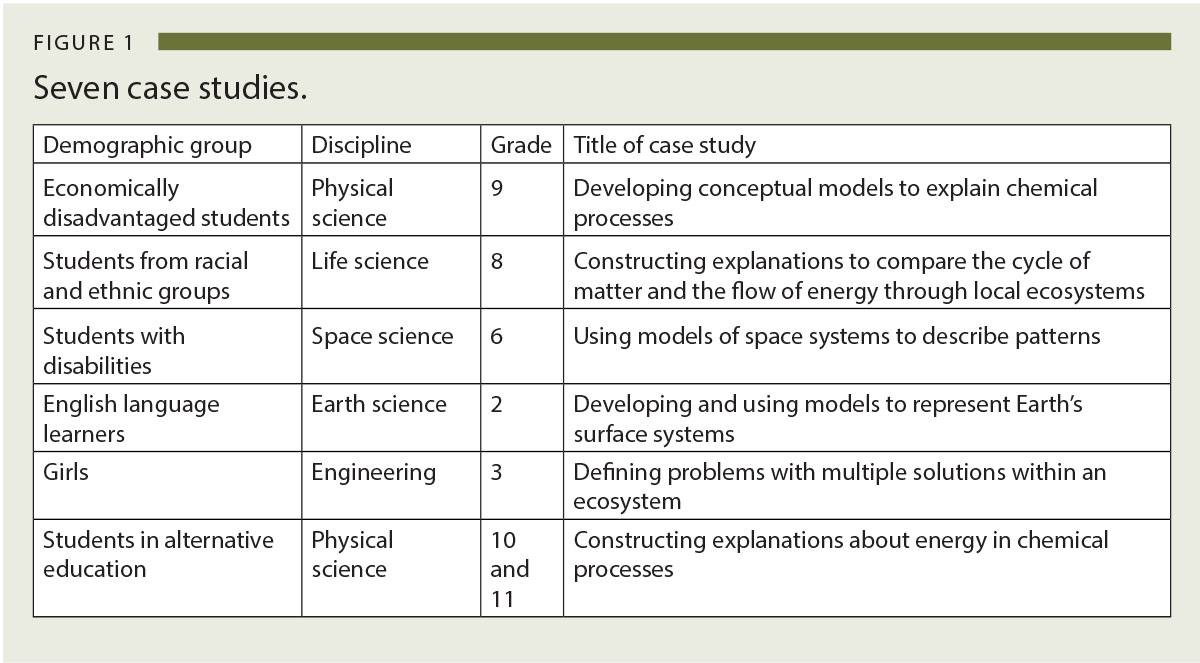Addressing Student Diversity and Equity
The Next Generation Science Standards are leading a new wave of reform.
While student demographics continue to change nationwide, science achievement gaps persist, as measured by the National Assessment of Educational Progress (NCES 2012). The National School Lunch Program feeds more than half of the nation’s public school students with free or reduced-price lunch (Southern Education Foundation 2015), and English language learners (ELLs) are now the fastest-growing student population. As traditional racial and ethnic minority students have become the numeric majority (NCES 2013), teaching science for all increasingly means addressing diverse student populations. Emerging now is a new wave of science education reform grounded in A Framework for K–12 Science Education: Practices, Crosscutting Concepts, and Core Ideas (NRC 2012) and the Next Generation Science Standards (NGSS Lead States 2013). The goal of this reform is to make all students ready to pursue STEM college degrees and careers and to be informed citizens. We would argue that this new wave of reform is more ambitious than that which followed the launch of the Soviet Union’s Sputnik—the first artificial satellite to orbit Earth—in 1957. While the “space race” education reform arguably targeted elite students with the potential to become future scientists (Rudolph 2002), the new wave calls for all students to learn academically rigorous science, become college and career ready, and take part in the global community. This article describes how the NGSS address diversity and equity issues and calls for next steps in implementing the NGSS for diverse student groups.
Diversity and equity in the NGSS
The NGSS address diversity and equity issues from the start in discussing what counts as science and who does science. First, in describing the nature of science, the NGSS state: “Men and women from different social, cultural, and ethnic backgrounds work as scientists and engineers” (NGSS Appendix H, p. 6). While scientists have traditionally been portrayed in popular culture as white males, nowadays scientists of color and female scientists serve as role models for students who otherwise might not consider science relevant to their lives or careers.
Second, from an epistemological perspective, including engineering in the NGSS addresses diversity as well. Much of the historical development in “Egyptian, Chinese, Greek, and Arabic cultures” (American Association for the Advancement of Science 1989, p. 136), and other cultures (e.g., Siamese, Balinese, Incan, Aztec, Aksum, Haida) involve engineering (i.e., designing solutions to problems) more than science (i.e., explaining phenomena) (Siegel 2002; Snively and Corsiglia 2001). By recognizing engineering, the NGSS open the door to contributions of non-Western cultures as demand for technological innovations grows.
The NGSS redefine what counts as science learning with four aspects particularly relevant to diversity and equity issues. First, the NGSS present performance expectations and weave together three dimensions—science and engineering practices, crosscutting concepts, and disciplinary core ideas—to explain phenomena and design solutions to problems. When phenomena and problems are placed in home and community contexts, diverse students build on their everyday experience and language to make connections among school science and home and community.
Another aspect is the central role of engineering. From a pedagogical perspective, by designing engineering solutions to problems in local contexts, students deepen their science knowledge and recognize science as relevant to their lives and future (Rodriguez and Berryman 2002). Exposure to engineering in local contexts (e.g., watershed improvement, habitat restoration, alternative energy innovation, local health initiatives) can generate students’ interest in studying STEM areas and inspire them to choose STEM-related college coursework or careers. Early engagement with engineering, fostered by the NGSS, is particularly important for students who have not traditionally considered science as a possible career pathway (Katehi, Pearson, and Feder 2009; NSF 2010).
A third aspect involves the focus on science and engineering practices, which represent a deepening and refining of “science inquiry” as broadly defined in the previous reform documents (AAAS 1989, 1993; NRC 1996). Because engagement in these practices is language intensive, it calls for a high level of classroom discourse for all students, especially ELLs and English speakers with limited literacy development (Lee, Quinn, and Valdés 2013). When supported appropriately, all students can comprehend (receptive language functions) and communicate (productive language functions) their science ideas using “less-than-perfect English” (NGSS Appendix D, 2013, p. 6). As a result, science classrooms adhering to the NGSS promote rich language learning and rigorous science learning.
The final aspect involves the explicitness of crosscutting concepts that connect interrelated ideas across science disciplines. This tacit understanding is often considered “background knowledge for students in ‘gifted’, ‘honors’, or ‘advanced’ programs” (NGSS Appendix D, 2013, p. 7). Through the NGSS, explicit teaching of crosscutting concepts has the potential to enable historically underserved students to make connections among science ideas.
Work of our NGSS Diversity and Equity Team
Of the 41 members of the NGSS writing team, a subgroup of seven members including six classroom teachers and one university professor with expertise on specific student groups formed the NGSS Diversity and Equity Team. Our task involved ensuring that NGSS be accessible to all students, thus the title of our work: “NGSS All Standards, All Students.” Student diversity was defined in terms of four federally designated groups: economically disadvantaged students, students from major racial and ethnic groups, students with disabilities, and students with limited English proficiency. We included three additional groups for student diversity: girls, students in alternative education programs, and gifted and talented students. Of the four charges that the team completed (for details, see Lee, Miller, and Januszyk 2014), we highlight Appendix D: All Standards, All Students, and seven case studies, one for each of the seven diverse student groups identified above.
Appendix D: All Standards, All Students
Appendix D focuses on student diversity and equity in relation to the NGSS specifically. First, the appendix addresses learning opportunities and demands that the NGSS present to all students, as discussed above—(1) three-dimensional learning as the keystone of the NGSS, (2) the inclusion of engineering from both epistemological and pedagogical perspectives for historically underserved students, (3) language learning opportunities and demands that science and engineering practices present to all students and ELLs in particular, and (4) potential benefits that crosscutting concepts offer to students who were traditionally relegated to basic courses.
To enable diverse student groups to meet the NGSS, Appendix D, presents effective classroom strategies identified in the current research literature across seven diverse student groups, each with a distinct research tradition. Some strategies are common to the student groups (e.g., funds of knowledge), but others address a particular group (e.g., home language and culture connections for ELLs, accommodations or modifications for students with disabilities). Commonalities in approach or strategies that have emerged across the seven areas of research literature include:
- capitalize on students’ cultural and linguistic resources from their backgrounds (e.g., home and community) that can serve as intellectual resources in the science classroom,
- connect students’ background knowledge (e.g., cultural or linguistic) with science disciplinary knowledge, and
- allocate school resources (e.g., material, human, and social) to support science learning (NGSS Appendix D, 2013, p. 21).
Appendix D brings together the seven student groups in terms of demographics, science achievement, and educational policies. The information based on data from government reports, including U.S. Census and National Center for Education Statistics, provides the context that influences science learning by diverse student groups at the national level.
Seven case studies
Seven case studies, written by the NGSS Diversity and Equity Team, illustrate examples for implementation of the NGSS with diverse student groups in classrooms settings. Each case study includes three parts that parallel the three parts of Appendix D described above:
- learning opportunities and demands that the NGSS present to all students,
- effective classroom strategies, and
- the context for each group in terms of demographics, science achievement, and educational policies.
In each case study, an extensive vignette describes NGSS implementation to illustrate learning opportunities and demands as all students engage in learning science. Each vignette emphasizes a particular student group and collectively they represent all four science disciplines in the NGSS (physical, life, Earth and space, and engineering) across grade levels (Figure 1). The titles of the case studies indicate the three dimensions of the NGSS, for example, “constructing explanations (practice) to compare the cycle of matter and the flow of energy (crosscutting concept) through local ecosystems (disciplinary core idea)” and “using models (practice) of space systems (disciplinary core idea) to describe patterns (crosscutting concept).” The lengths of science instruction involved vary, ranging from a few weeks to an entire school year.
The vignettes emphasize what teachers can do to successfully engage diverse student groups in meeting the NGSS. Each vignette describes students’ learning progressions from initial explanations or models of phenomena to more sophisticated explanations or models. As students move toward meeting the standards, each vignette highlights three-dimensional learning of the NGSS, connections to the Common Core State Standards for English language arts and mathematics (NGAC and CCSSO 2010), and use of effective classroom strategies.

Moving forward
Because the NGSS advocate academic rigor for all students, significant shifts in many teachers’ knowledge and instructional practices may be vital to enable all students to explain a phenomenon or design solutions to a problem by engaging in three-dimensional learning. Using the Framework and NGSS as road maps, next steps will involve implementation plans for classroom teaching, curriculum materials, assessment, and teacher preparation and professional development. The NGSS Diversity and Equity Team encourages all teachers to make diversity and equity issues central to the process.



